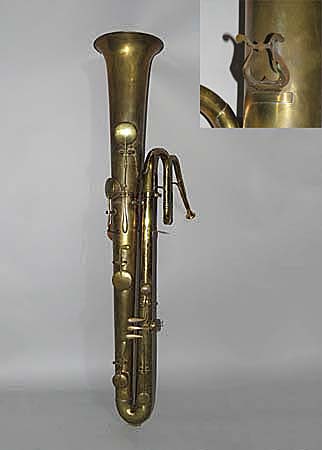
Owner: HWMC
Catalog#: CL-AELV-210
Cornetti / Serpents / Ophicleides
Darche 'Quinticlave in Eb'
Paris, France
Jean Nicolas Darche
Metal, brass, leather
ca. 1840-1855
Length: 44 inches
Wind Instruments – Brass Instruments – Cornetti / Serpents / Ophicleides
Engraved on the bell: DARCHE / BREVETE / DARCHE
This is a quinticlave, also called an alto ophicleide, in Eb with 9 keys by Jean Nicolas Darche. The name “ophicleide” means “keyed serpent,” and is believed to have been invented in 1817 and patented in 1821 by French instrument maker Jean Hilaire Asté (also known as Halary or Haleri).
It is the bass member of the keyed bugles, replacing the serpent in the mid-19th century and occasionally served as a solo instrument. Eventually it was succeeded by the tuba and euphonium respectively by the beginning of the 20th century.
Darche is a well-known family name of luthiers from Mirecourt and Brussels but also includes a wind instrument maker in Paris. Jean Nicolas DARCHE (1806-1885) of Mirecourt, France, arrived in Paris around 1825 and worked with Claude Hippolyte Collin (1766-1831). a luthier and musical instrument dealer. Following Collin’s death, Darche bought the business from Collin’s widow and continued to supply all types of instruments including flutes, clarinets, and flageolets. In 1840 he produced, in collaboration with the trumpeter Schlitz, the natural straight trumpets. Then in 1841 he proposed the invention: keyboard flageolets called ‘flageolet a clavier,’ and in 1843 obtained a five-year patent for a combination bass drum and snare drum that could be used as a harmony timpani. In 1844 he presented church organs, timpani, and bass drums at the Paris exhibition. Then in 1846, he obtained a new patent for a ‘transposing piston keyboard applicable to all keyboard instruments. Finally in 1848 he obtained a patent for a so called ‘signal trumpet’ instrument suitable as a ship siren. In other words, a type of ‘foghorn.’ Then at the 1849 Paris exhibition in Paris he received a medal of honor for trumpets and chromatic trumpets.’
By 1855 he passed the business on to his nephew Eugene Leopold Henry (1819-1872), who associated with Jules David Martin (1826-1872) are known as Henri & Martin. They were the first to make an agreement with Adophe Sax to manufacture saxhorns and saxotrombas under the Sax License. Reference: http://facteursetmarchand sdemusique.blogspot.fr/2014/12/la-famile-darche-luthers-de-mirecourt.html; https://1-rp–archivesmusiquefacteurs-blogspot-com.translate.goog/2016/11/la-famille-darche-luthiers-de-mirecourt_25.html?_x_tr_enc=1&_x_tr_sl=fr&_x_tr_tl=en&_x_tr_hl=en&_x_tr_pto=nui,sc; ‘The New Lanagwill Index: A Dictionary O Musical Wind Instrument Makers and Inventors,’ 1993, William Waterhouse. Pub. Tony Bingham., pp. 80-81
